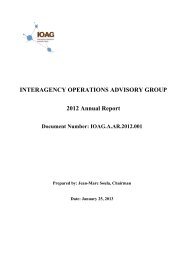OLSG Report_Final_06_05_12 - Interagency Operations Advisory ...
OLSG Report_Final_06_05_12 - Interagency Operations Advisory ...
OLSG Report_Final_06_05_12 - Interagency Operations Advisory ...
You also want an ePaper? Increase the reach of your titles
YUMPU automatically turns print PDFs into web optimized ePapers that Google loves.
Table 30: Scenario ground costs<br />
LEO Lunar L2 L1<br />
Optical Link Study Group (<strong>OLSG</strong>) <strong>Final</strong> <strong>Report</strong><br />
IOAG.T.<strong>OLSG</strong>.20<strong>12</strong>.V1<br />
Deep<br />
Space<br />
Single Relay<br />
Optical FL<br />
(Case b)<br />
Percent data transmitted (PDT) 94.8% 97.4% 99.9% 98.5% 98.0% 99.0%<br />
Number of stations required to<br />
achieve PDT: 7 2 2 2 2 3<br />
Initial Scenario Ground<br />
Investment Costs (k€):<br />
Terminal (telescope, dome, and<br />
electronics) 3,367 15,264 10,904 <strong>12</strong>,460 102,810 13,078<br />
Aviation Safety System 2,450 700 700 700 700 1,<strong>05</strong>0<br />
Weather and Atmospheric<br />
monitoring 1,750 500 500 500 500 750<br />
Site Facilities Investment Costs<br />
(Buildings, Power, energy, etc.) 4,650 3,<strong>12</strong>0 1,953 1,953 6,230 4,288<br />
Wide Area Communication<br />
Investment Costs (ground<br />
communication) 2,188 157 1,242 1,242 157 1,560<br />
Subtotal Initial Scenario Ground<br />
Investment Costs (k€) 14,4<strong>05</strong> 19,741 15,299 16,855 110,397 20,726<br />
Recurring Scenario Ground<br />
Operating Costs (k€):<br />
Site and Terminal Operating Costs 3,<strong>12</strong>0 2,336 2,336 2,336 3,<strong>12</strong>0 3,116<br />
Communication Operating Costs 2,730 780 780 780 780 1,170<br />
Subtotal Recurring Scenario<br />
Ground Operating Costs (k€) 5,850 3,116 3,116 3,116 3,900 4,286<br />
5.1.1 Aspects of Site Selection<br />
Because availability of site facilities and wide area telecommunication infrastructure are<br />
highly dependent on the chosen location, some aspects of site selection are elaborated<br />
further in this section of the report. Prospective sites for future ground stations should be<br />
evaluated to determine if they can provide support to multiple missions or scenarios to<br />
minimize the number of global sites that must be maintained. Such sites may host more<br />
than one type of terminal to achieve this capability, or host single terminals conforming to a<br />
common standard that are able to communicate with more than one mission or scenario<br />
type.<br />
Site selection depends upon two primary factors:<br />
• Weather—cloud free line of sight statistics, atmospheric conditions, wind,<br />
dust, etc.<br />
• Infrastructure—readily available and usable land, electrical power, roads,<br />
telecommunications, etc. Note that the telecommunication requirement will<br />
ultimately be driven by the mission data rate and the allowable latency in<br />
data delivery. For example, a station supporting a downlink from a GEO relay<br />
at 10 Gb/s will likely need at least a 10 Gb/s communication link to the user,<br />
Page | 136



